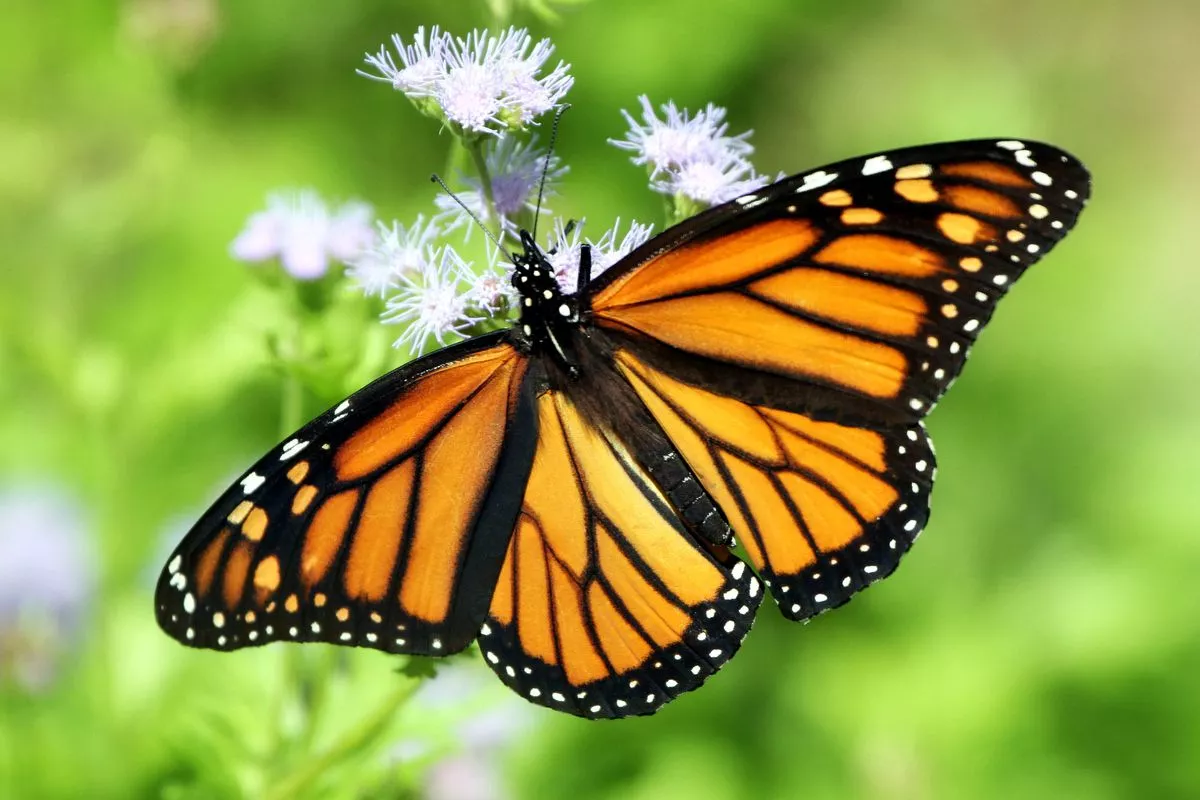Many miles can be covered by monarch butterflies in a single day.
In North America, they are an astounding and daring species. However, over the past few decades, populations of the migratory monarch butterfly, a well-known subspecies of the monarch, have decreased in some areas.
Migrating species have recently been added to the dreaded Red List, which is a depressing compilation of species that the International Union for Conservation of Nature (IUCN) determines are threatened or endangered. The IUCN says that the number of migratory monarchs in their winter nesting areas has dropped by 22 to 72%, and they are now in danger of going extinct.
The red-listing of monarch butterflies by an international organization may make it seem urgent to take immediate action to conserve them, but it has no legal effect in the United States. But because these beautiful bugs face so many dangers, many ecologists say it’s long past time to protect monarchs from going extinct.
Emma Pelton, a biologist who took part in the latest IUCN monarch assessment, says that it’s hard for people to understand that an animal they see every summer is in danger.
A remarkable species
The iconic species is noteworthy for a variety of reasons. Monarch butterflies are excellent pollinators. When monarch butterflies drink nectar from flowers, pollen dust adheres to their bodies, just like it does for bees, enabling them to transport pollen and fertilize other plants.
The only butterfly species that successfully complete a two-way migratory cycle, like birds, is the monarch. Every fall, millions of monarch butterflies fly up to an incredible 3,000 miles from their North American breeding grounds, where they spend the summer, to spend the winter in Mexico’s forests (a phase called “overwintering”). In the alpine climate of Mexico, monarch butterflies can slow down their metabolism, store energy, and keep from freezing.
John Pleasants, an associate professor of ecology at Iowa State University, says that monarchs also face risks when they stay in one place for the winter.
The waning of the monarch
According to Pleasants, there have been three significant monarch mortality events in the overwintering sites since the mid-1990s. He claimed that during these intense winter storms, butterflies perish from exposure to the elements. Due to the dryness, even leaving Mexico and heading north toward Texas leaves them vulnerable to the winter. You won’t get off to a good start if the weather is too hot or too dry, he warned.
In addition to these inherent environmental challenges, human activities like habitat destruction and deforestation wipe out milkweed plants, which monarch butterflies completely depend on for egg-laying during migration. According to Pleasants, overuse of pesticides is to blame for the decline in milkweed.
Monarch populations sharply decreased from the late 1990s to 2007. According to Pleasant’s research, the drop was caused by the popular Roundup Ready herbicide, which is frequently sprayed both before and after crops are sown in order to manage weeds. According to Pleasants, the herbicide had no effect on corn or soybeans but destroyed every other plant in the fields, including milkweed.
Herbicide use, habitat loss, and occurrences of natural mass mortality all have negative effects. According to Pleasant, monarchs should be classified as endangered because of this.
At Arizona’s Center for Biological Diversity, endangered species policy specialist Stephanie Kurose said, “It’s truly upsetting that these monarchs have to be classified as endangered by the IUCN.” According to Kurose, there is an 80% possibility that migrating monarchs will go extinct in the next 50 years.
She also acknowledged that monarchs in the United States are not legally protected by the IUCN red listing.
Monarchs are not yet protected
The IUCN is a global organization of experts that assesses the dangers faced by a species and, if necessary, adds it to its list of endangered or threatened species. The conservation organization updates its list of endangered species, which includes over 41,000 animal and plant species, multiple times a year. Despite this, the IUCN’s Red List designation does not confer legal protections on endangered species in the United States.
Instead, the U.S. Fish and Wildlife Service is the organization in charge of creating legislative safeguards for species and collaborating with experts to bring back extinct animals and plants to stable population levels. Congress enacted the robust Endangered Species Act in 1973, giving the Fish and Wildlife Service the authority to safeguard and restore endangered species like the Bald Eagle. Importantly, the organization provides funding for the preservation of endangered species. (However, it’s crucial to note that research has shown that the majority of endangered species are underfunded, which makes it difficult to restore many threatened animals.)
The migrating monarchs have not yet been classified as endangered by the Fish and Wildlife Service. Given the risks the monarch butterfly faces, the agency decided in 2020 that “listing the monarch butterfly as an endangered or vulnerable species is justifiable,” but there is a long list of other plant and animal species that need to be saved first.
The Center for Biological Diversity’s Kurose told Mashable, “We really need the Biden administration to swiftly preserve monarch butterflies under the Endangered Species Act.” Kurose mentioned that the organization might decide to safeguard monarchs in 2024. Pelton, who also oversees the monarch conservation program at the conservation nonprofit Xerces Society, said that his organization was one of the original petitioners to have the Fish and Wildlife Service review and, ideally, list the monarch. We have been a part of that group for a long time, she added.
Additionally, Pelton told Mashable that bringing attention to a well-known flagship species like monarchs might pique the public’s interest in protecting not only monarchs but also other wild animals.
However, not all experts agree with the IUCN’s classification of the well-known butterfly species as endangered. The timing of this decision raises concerns for Andy Davis, an animal biologist at the University of Georgia, given that some monarch populations have been doing pretty well in North America over the last few years. According to Davis, “This judgment is predicated on a misunderstanding of the biology of the monarchs and possibly a misunderstanding of science.”
In a recent study, Davis examined summertime fluctuations throughout monarch populations in their nesting region. However, Davis noted that the IUCN’s analysis is based on the size of the wintering colony. He suggested that, because they don’t travel around much during the winter, it might be simple to count the monarchs. However, counting the number of butterflies during their springtime reemergence, as Davis’ study did, provides a more accurate representation of their population size because that is when they breed, according to Davis. Davis claims that there is no proof that the breeding range is getting smaller.
Ecologists agree that the general monarch population has not decreased for the past 10 to 15 years and that their numbers have stayed almost stable. Orley R. Taylor, Jr., is the director of Monarch Watch, an organization that monitors monarch migration. However, Taylor argues that given the unpredictability of the long-term threats posed by climate change, there is some reason for adding monarchs to the IUCN endangered list. According to him, excessive rain and altered weather patterns have caused numerous mass deaths of monarchs over the previous few decades. Taylor told Mashable, “We have been fortunate thus far because the population has been fairly robust.”
Taylor’s ideas are shared by Pleasants of Iowa State University. There will still be tens of millions of monarchs even if 75% of them pass away. However, as the population shrinks, there is a possibility that it will get too small and vulnerable. Pleasants says that by 2013, the area where monarch butterflies spend the winter in Mexico had already shrunk to 2.67 hectares, which is about the size of a football field.
Together, Taylor said, the IUCN’s decision emphasizes the importance of taking preventative measures to safeguard monarchs even if there is some scientific ambiguity regarding their future. If you don’t know what’s happening, behave safely. IUCN’s initiative is about that.






Leave a Reply